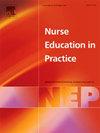通过马拉维的模拟教育学习产后出血:一项混合方法研究
IF 3.3
3区 医学
Q1 NURSING
引用次数: 0
摘要
目的探讨助产学学生运用模拟教学方法学习产后出血患者管理的经验。马拉维刚刚开始实施基于模拟的教育,尽管它被推荐用于助产教育以提高患者安全。因此,为了确保将模拟教育成功地纳入助产培训计划,了解学生在教学方法方面的经验是至关重要的。设计本研究采用描述性混合收敛设计。方法共有177名助产学学生参与了这项研究。通过问卷调查和三次焦点小组讨论收集数据。定量和定性资料分别采用描述性统计和内容分析进行分析。结果学生对模拟设计要素、教育实践、学生学习满意度和自信心等问题进行了定量评分,平均分均在4分以上。定性数据分析产生了一个主题和两个副主题。主题:模拟镜专业实践所需能力;分主题:(1)现实主动的学习方法;(2)有利于学生学习的环境。结论助产学学生体验模拟是一种有价值的教学方法,反映了他们在资源有限的环境中作为专业人员实践所必需的产后管理临床技能。需要更多的研究来探索马拉维基于模拟的教育的可行性,以及学生是否可以将在模拟中获得的知识和技能应用于临床实践,特别是在受限的环境中。本文章由计算机程序翻译,如有差异,请以英文原文为准。
Learning postpartum haemorrhage through simulation-based education in Malawi: A mixed method study
Aim
The aim of the study was to explore midwifery students’ experiences with simulation as pedagogic method when learning management of postpartum haemorrhage patients.
Background
Malawi is just starting to implement simulation-based education, even though it is recommended in midwifery education to enhance patient safety. Therefore, to ensure successful incorporation of simulation-based education into midwifery training programs, it is crucial to understand students’ experiences with the pedagogic method.
Design
The study applied a descriptive-mixed-convergent design.
Method
One-hundred and seven midwifery students participated in the study. Data were collected through questionnaires and three focus group discussions. Quantitative and qualitative data were analysed using descriptive statistics and content analysis respectively.
Results
Quantitatively, students graded all the questions related to the simulation design elements, educational practices and students’ satisfaction and self-confidence in learning with mean scores above four on a 5-point Likert Scale. One theme and two sub-themes emerged from qualitative data analysis. Main theme: simulation mirrors demanded competence for professional practice; sub-themes: (1) a realistic and active learning method; and (2) a conducive environment for students’ learning.
Conclusion
Midwifery students experienced simulation as a valued pedagogical approach to teaching and learning that mirrored postpartum management clinical skills necessary for them to practice as professionals in the resource-limited setting. More research is necessary to explore feasibility for simulation-based education in Malawi and whether students can apply the knowledge and skills acquired during simulation into clinical practice particularly within constrained environment.
求助全文
通过发布文献求助,成功后即可免费获取论文全文。
去求助
来源期刊

Nurse Education in Practice
NURSING-
CiteScore
5.40
自引率
9.40%
发文量
180
审稿时长
51 days
期刊介绍:
Nurse Education in Practice enables lecturers and practitioners to both share and disseminate evidence that demonstrates the actual practice of education as it is experienced in the realities of their respective work environments. It is supportive of new authors and will be at the forefront in publishing individual and collaborative papers that demonstrate the link between education and practice.
 求助内容:
求助内容: 应助结果提醒方式:
应助结果提醒方式:


